DODGE SPRINTER 2005 1.G Owners Manual
Manufacturer: DODGE, Model Year: 2005, Model line: SPRINTER, Model: DODGE SPRINTER 2005 1.GPages: 288, PDF Size: 27.89 MB
Page 151 of 288

STARTING AND OPERATING 151
5
The system is operational if after reverse gear is
engaged:
an acknowledgement tone sounds
the multi-function indicator shows the distance to an obstacle that has been detected.
WARNING!
The reversing aid is feature designed to provide as-
sistance and may not detect all obstacles. The sys-
tem is not a replacement for your own diligence.
The reversing aid does not detect people and/or
objects within a range of approximately 12 in (30
cm). There is a possibility that certain objects
which could come into contact with the vehicle at
the rear will not be detected by the system’s
sensors. This could cause an accident resulting in
severe personal injuries, death and property
damage.
For this reason, you should make sure before
manuevring that no people or animals are in the
maneuvring range of the vehicle.
Pay particular attention to people and/or objects
above or below sensors when parking, such as
small children, toddlers, flower pots or trailer
towbars.
You are always responsible for safety at all times
and must continue to pay attention to your
immediate surroundings when manoeuvring. A
second person should assist you in manouevring if
necessary.
Page 152 of 288
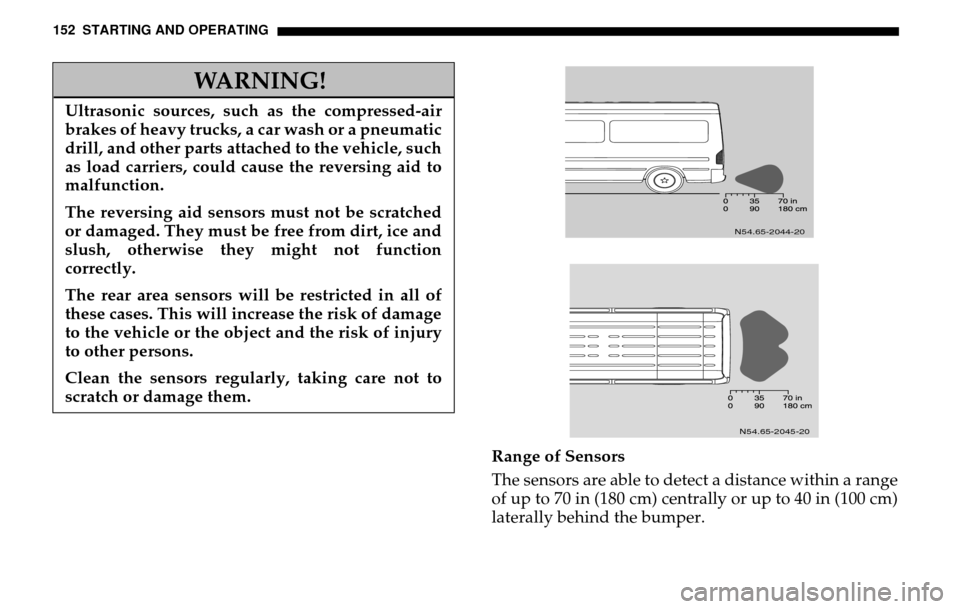
152 STARTING AND OPERATING
Range of Sensors
The sensors are able to detect a distance within a range
of up to 70 in (180 cm) centrally or up to 40 in (100 cm)
laterally behind the bumper.
WARNING!
Ultrasonic sources, such as the compressed-air
brakes of heavy trucks, a car wash or a pneumatic
drill, and other parts attached to the vehicle, such
as load carriers, could cause the reversing aid to
malfunction.
The reversing aid sensors must not be scratched
or damaged. They must be free from dirt, ice and
slush, otherwise they might not function
correctly.
The rear area sensors will be restricted in all of
these cases. This will increase the risk of damage
to the vehicle or the object and the risk of injury
to other persons.
Clean the sensors regularly, taking care not to
scratch or damage them.
N54.65-2044-20N54.65-2045-20
Page 153 of 288

STARTING AND OPERATING 153
5
For all sensors, the minimum distance between sensor
and obstacle is 12 in (30 cm).
In the event of a malfunction, a continuous warning
signal sounds for approximately three seconds when
the vehicle is reversingNOTE: Distance display– "in" in USA only
– "cm" in Canada only
LOADING THE VEHICLE
WARNING!
Do not overload the tires by exceeding the specified
vehicle capacity weight (as indicated by the label on
the base of the driver’s seat). Overloading the tires
can overheat them, poss ibly causing a blowout,
which could cause an accident and personal injury.
In addition, braking and stopping distances can be
significantly longer if the vehicle is overloaded.
WARNING!
Always close the sliding and rear doors when
driving.
Otherwise exhaust fumes could enter the vehicle
interior and poison you.
Page 154 of 288

154 STARTING AND OPERATING
The handling characteristics of a vehicle when laden
are dependent on the type of load and the distribution
of the load within the vehicle.
Carrying heavy or bulky loads may alter the vehicle’s
handling characteristic.Loading GuidelinesPlease note and comply with the following information
when loading and transporting goods.
Do not allow the load, including passengers, to exceed the permitted gross vehicle weight or the
permitted axle loads for the vehicle. Bear in mind
that the unladen weight could be increased by
installing items of optional equipment and
accessories.
Distribute the load uniformly. Excessive loads on individual points of the load surface could cause
damage to the floor covering.
Transport heavy loads between the axles near the rear axle as low as possible in the vehicle.
Secure any kind of load with sufficient wear and tear-resistant load restraints. See tie-down rings.
WARNING!
Unsecured or poorly secured loads, and seats that
have been removed, could move around the vehi-
cle interior uncontrollably in the event of sudden
braking, a rapid change in direction or an acci-
dent. This increases the risk of injury to occu-
pants in these situations.
Secure and position a load as described in the
following loading guidelines.
Piling up heavy objects or placing them on upper
shelves or loading them otherwise high up in the
vehicle will significantly raise the center of
gravity of the vehicle. Placing excessive loads on
individual points of the load surface or behind
the rear axle will also adversely affect the
handling characteristics of your vehicle and may
lead to loss of control over the vehicle.
Road safety and tire durability are adversely
affected if the permissible axle loads or gross
vehicle weight are exceeded due to the vehicle’s
load. Braking and stopping distances can be
significantly longer.
Page 155 of 288

STARTING AND OPERATING 155
5
Protect sharp edges with padding.
Check the tire pressures after loading the vehicle.
For passenger vans:
Do not stack loads higher than the upper edge of the backrests.
Always place the load against the backrests of the seat benches.
Whenever possible, transport loads behind seats that are not occupied.
Distribute the load in such a way that the permissible axle loads are not exceeded when the
vehicle is equipped with the maximum number of
seats. Loading the luggage compartment up to the
maximum payload would cause the permissible
rear axle load to be exceeded.
BRAKES
Service Brake
WARNING!
When the engine is not running, the brake and
steering systems are without power assistance.
Under these circumstances, a much greater effort
is necessary to stop or steer the vehicle.
After driving in heavy rain for some time without
applying the brakes or through water deep
enough to wet brake components, the first
braking action may be somewhat reduced and
increased pedal pressure may be necessary. Be
sure to maintain a safe distance from vehicles in
front.
Resting your foot on the brake pedal will cause
excessive and premature wear of the brake pads.
It can also result in the brakes overheating,
thereby significantly reducing their effectiveness.
It may not be possible to stop the vehicle in
sufficient time to avoid an accident.
Page 156 of 288
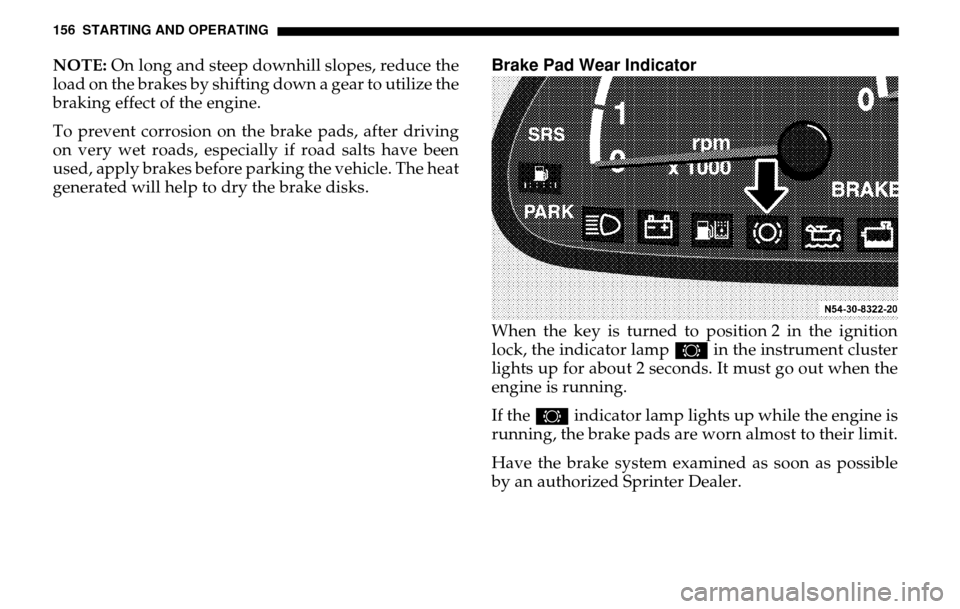
156 STARTING AND OPERATINGNOTE: On long and steep downhill slopes, reduce the
l o a d o n t h e b r a k e s b y s h i ft i n g d o w n a g e a r t o u t i l i z e t h e
braking effect of the engine.
To prevent corrosion on the brake pads, after driving
on very wet roads, especially if road salts have been
used, apply brakes before parking the vehicle. The heat
generated will help to dry the brake disks.
Brake Pad Wear IndicatorWhen the key is turned to position 2 in the ignition
lock, the indicator lamp 2 in the instrument cluster
lights up for about 2 seconds. It must go out when the
engine is running.
If the 2indicator lamp lights up while the engine is
running, the brake pads are worn almost to their limit.
Have the brake system examined as soon as possible
by an authorized Sprinter Dealer.
Page 157 of 288
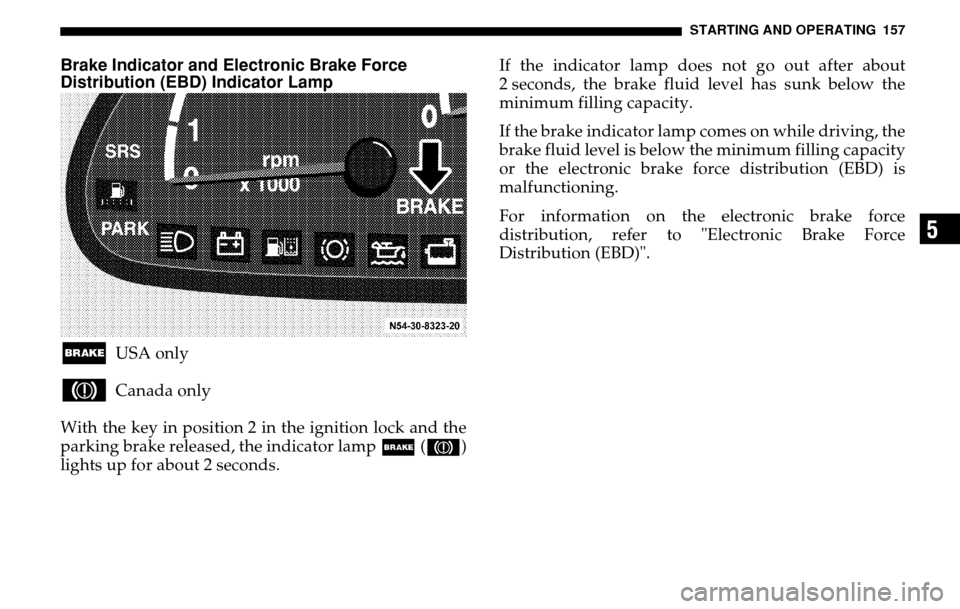
STARTING AND OPERATING 157
5
Brake Indicator and Electronic Brake Force
Distribution (EBD) Indicator Lamp;
USA only
3
Canada only
With the key in position 2 in the ignition lock and the
parking brake released, the indicator lamp ; (3 )
lights up for about 2 seconds. If the indicator lamp does not go out after about
2 seconds, the brake fluid level has sunk below the
minimum filling capacity.
If the brake indicator lamp comes on while driving, the
brake fluid level is below the minimum filling capacity
or the electronic brake force distribution (EBD) is
malfunctioning.
For information on the electronic brake force
distribution, refer to "Electronic Brake Force
Distribution (EBD)".
Page 158 of 288
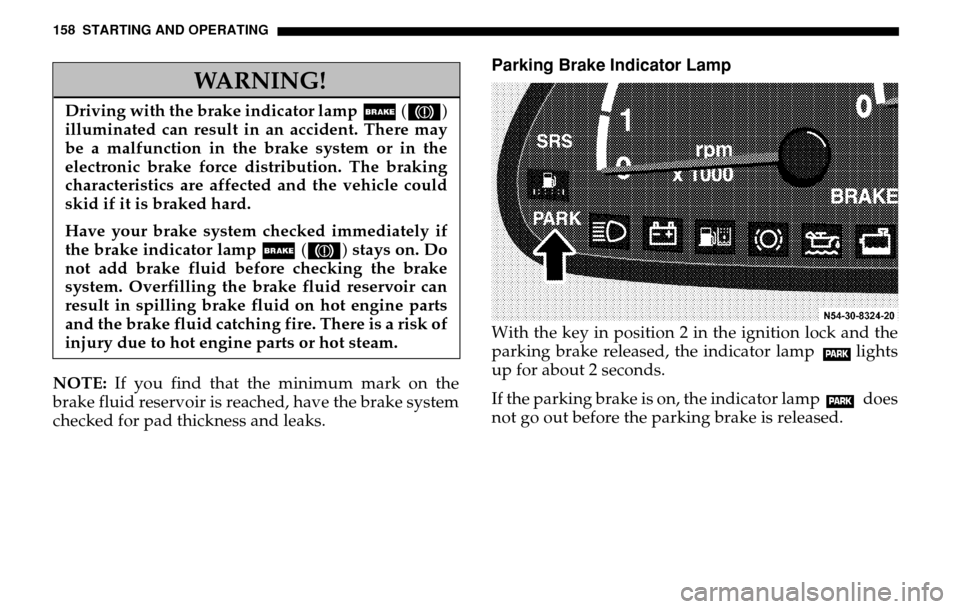
158 STARTING AND OPERATINGNOTE: If you find that the minimum mark on the
brake fluid reservoir is reached, have the brake system
checked for pad thickness and leaks.
Parking Brake Indicator LampWith the key in position 2 in the ignition lock and the
parking brake released, th e indicator lamp lights
up for about 2 seconds.
If the parking brake is on, the indicator lamp does
not go out before the parking brake is released.
WARNING!
Driving with the brake indicator lamp ; (3 )
illuminated can result in an accident. There may
be a malfunction in the brake system or in the
electronic brake force distribution. The braking
characteristics are affected and the vehicle could
skid if it is braked hard.
Have your brake system checked immediately if
the brake indicator lamp ; (3 ) stays on. Do
not add brake fluid before checking the brake
system. Overfilling the brake fluid reservoir can
result in spilling brake fluid on hot engine parts
and the brake fluid catching fire. There is a risk of
injury due to hot engine parts or hot steam.
Page 159 of 288
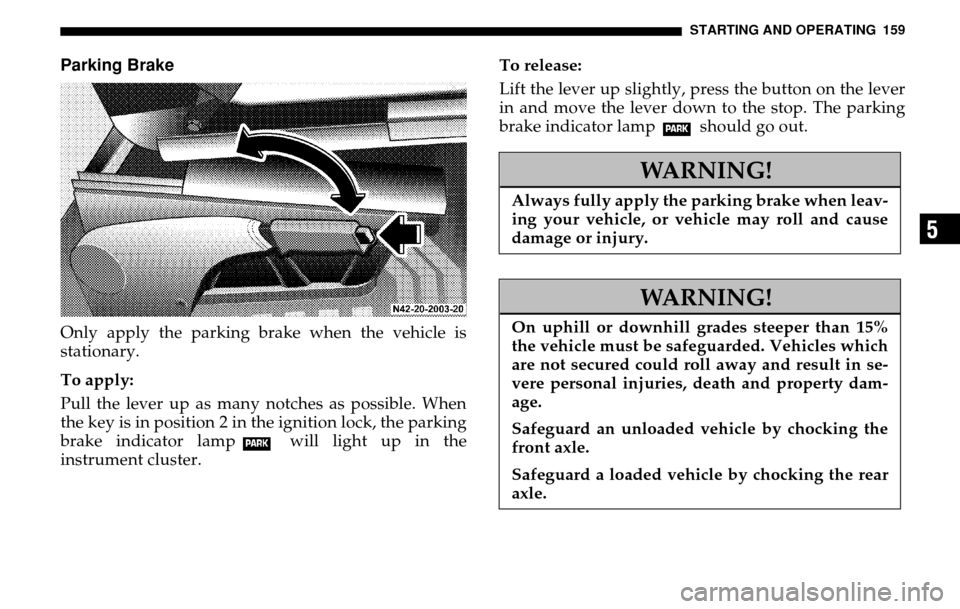
STARTING AND OPERATING 159
5
Parking BrakeOnly apply the parking brake when the vehicle is
stationary.
To apply:
Pull the lever up as many notches as possible. When
the key is in position 2 in the ignition lock, the parking
brake indicator lamp will light up in the
instrument cluster. To release:
Lift the lever up slightly, press the button on the lever
in and move the lever down to the stop. The parking
brake indicator lamp should go out.
WARNING!
Always fully apply the parking brake when leav-
ing your vehicle, or vehicle may roll and cause
damage or injury.
WARNING!
On uphill or downhill grades steeper than 15%
the vehicle must be safeguarded. Vehicles which
are not secured could roll away and result in se-
vere personal injuries, death and property dam-
age.
Safeguard an unloaded vehicle by chocking the
front axle.
Safeguard a loaded vehicle by chocking the rear
axle.
Page 160 of 288

160 STARTING AND OPERATING
Driving Safety SystemsThe vehicle can be equipped with the following
Driving Safety Systems:
Anti-lock brake system (ABS)
Electronic brake force distribution (EBV)
Acceleration skid control (ASR)
Brake assist system (BAS)
1
Electronic stability program (ESP)
*
NOTE: The maximum effectiveness of ABS, EBV, ASR
and ESP is only achieved if you drive with correct tire
pressures and adjust tire pressures to correspond with
the vehicle’s load. In winter operation, the maximum
effectiveness of the ABS and the ESP is only achieved
with winter tires (M+S tires), or snow chains as
required.
WARNING!
When leaving the vehicle always remove the key
from the ignition lock, and lock your vehicle.
Do not leave children unsupervised in the vehicle,
even if they are secured by a child restraint
system. The children could
injure themselves on parts of the vehicle
release the child-proof locks by pressing the central locking button and could thereby open
the doors and
cause injury to others as a result
get out of the vehicle and could either injure themselves when doing so or they could be
injured by the traffic approaching from the rear
suffer serious or fatal effects in the event of long periods of hot weather
release the parking brake. The vehicle could then start moving of its own accord.Unsupervised use of vehicle equipment may cause
severe personal injuries, death and property damage.